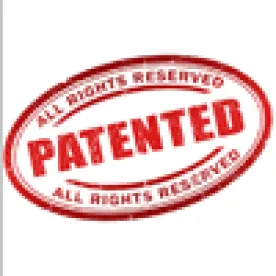Takeaway: An obviousness analysis need not seek out precise teachings directed to the specific subject matter of the challenged claim, for a court can take account of the inferences and creative steps that a person of ordinary skill in the art would employ.
In its Final Written Decision, the Board found that Petitioner had shown by a preponderance of the evidence that all challenged claims are unpatentable. The ’381 patent “is directed to a method for triggering an event in a roving apparatus when the position of the roving apparatus is within a predetermined area, and at least one specified triggering criterion is met.”
The Board first addressed claim construction under the broadest reasonable interpretation in light of the specification. The parties did not dispute the Board’s construction set forth in the Decision on Institution, and therefore, the Board adopted its previous construction. In particular, the term “bearing” was defined as “measurement of direction between two points,” and the term “heading” was defined as “direction of travel.”
Turning to the asserted obviousness grounds of claims 1-12 over the Fast and Buss references, the Board was persuaded that Petitioner had shown unpatentability by a preponderance of the evidence. First, the Board addressed Patent Owner’s arguments attacking the motivation to combine Fast and Buss. In particular, Patent Owner argued that “(1) the references are directed to different fields of application and intended purposes; (2) the systems described in Fast and Buss have different system architectures; and (3) Dr. Reynolds applied an incorrect methodology in his analysis.”
Addressing each argument in turn, the Board first found that Patent Owner “overstates the differences between the references,” finding that the systems are not “so different that a skilled artisan would not have thought to combine them.” With respect to Patent Owner’s second argument regarding the system architectures, as Petitioner pointed out, “obviousness analysis does not require bodily incorporation of one reference into another,” but “the appropriate inquiry is whether a person skilled in the art ‘would have seen an apparent reason to combine the point of interest notification functionality of Buss into Fast.’” The Board was persuaded by Petitioner’s arguments that the combination would have been obvious. With respect to Patent Owner’s third argument, Patent Owner asserted that Petitioner’s expert analyzed the prior art from the perspective of a person of ordinary skill in the art as of July 1998 rather than the time of the invention in 1995 and impermissibly relied on hindsight reasoning. The Board was not persuaded, finding that Patent Owner does not demonstrate “how the disclosures in Fast and Buss would have been beyond the level of ordinary skill in the art as of November 9, 1995.”
The Board then analyzed the disclosures of the Fast and Buss with respect to the limitations of the challenged claims. The Board first noted that the challenged method claims recite a step of triggering an event that was conditional, and therefore, under the broadest reasonable interpretation, the prior art need not disclose the limitations in order to render the claims unpatentability. Nevertheless, having considered the parties’ arguments and the disclosure of the references, the Board was persuaded by Petitioner’s arguments and claim interpretation, finding that the challenged claims would have been obvious over Fast and Buss.
The Board also noted that it was persuaded by Petitioner’s expert testimony related to the use of conventional techniques by a person of ordinary skill in the art to define particular ranges recited in dependent claims 3, 4, 9, and 10. In particular, the Board stated that “an obviousness ‘analysis need not seek out precise teachings directed to the specific subject matter of the challenged claim, for a court can take account of the inferences and creative steps that a person of ordinary skill in the art would employ.’” (quoting KSR Int’l Co. v. Teleflex, Inc., 550 U.S. 398, 418 (2007)). According to the Board, “Patent Owner does not identify any evidence that determining a range of bearings was beyond the skill level of an ordinarily skilled artisan.” (citing Leapfrog Enters., Inc. v. Fisher-Price, Inc., 485 F.3d 1157, 1162 (Fed. Cir. 2007)).
The Board next addressed secondary considerations of nonobviousness, and particularly, Patent Owner’s arguments related to alleged commercial success. The Board found that Patent Owner had not identified a commercially successful product “with sales directly attributable to the methods claimed in the ’381 patent.” In particular, the Board noted that Patent Owner did not establish how the allegedly commercially successful products embodied the challenged claims, holding that its citation to 54 pages of Infringement Contentions from the related litigation amounted to improper incorporation by reference. Moreover, with respect to Patent Owner’s arguments related to Petitioner’s $135 million acquisition of WHERE, Inc. and WHERE’s U.S. Patent No. 7,848,765, the Board stated that Patent Owner did not establish how the WHERE patent was similar to the challenged ’381 patent, and “what, if any, part of the $135 million Petitioner paid to acquire WHERE is specifically attributable to the WHERE patent, as compared to other assets acquired by Petitioner in the transaction.” Thus, the Board was not persuaded by Patent Owner’s evidence of commercial success.
eBay Inc. v. Locata LBS LLC, IPR2014-00585
Paper 31: Final Written Decision
Dated: October 2, 2015
Patent: 6,259,381 B1
Before: Mitchell G. Weatherly, Miriam L. Quinn, and Jo-Anne M. Kokoski
Written by: Kokoski
Related Proceedings: Pillar Vision, Inc. v. InfoMotion Sports Technologies, Inc., No. 2:14-cv-00043-RDP (N.D. Ala. filed Jan. 8, 2014)



 />i
/>i

